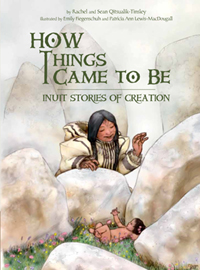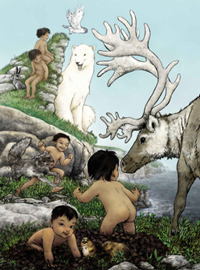| ________________
CM . . .
. Volume XXII Number 6. . . .October 9, 2015

 |
How Things Came to Be: Inuit Stories of Creation.
Rachel and Sean Qitsualik-Tinsley. Illustrated by Emily Fiegenschuh and Patricia Lewis-MacDougall.
Iqaluit, NU: Inhabit Media, 2015.
80 pp., hardcover, $16.95.
ISBN 978-1-927095-78-2.
Subject Heading:
Inuit-Fiction.
Kindergarten-grade 5 / Ages 5-10.
Review by Chasity Findlay.
***˝ /4
|
| |
|

excerpt:
It was all so long ago. Where was time? It had not yet been dreamed up.
The Grand Sky people say that stone fell from the Sky. Soil, too. All the things of the Land.
Once stone and soil had fallen, babies came. They emerged from the Land like flowers. Life came from the Land. There was little difference between animals and humans. All were equal beings. Every creature could understand every other. They lived with each other. Learned from one another.
They were family.
There was life in those days, but no death. Nor was there light, until someone cried, “Light!”
Nor was there darkness, until someone cried, “Dark!”
The Sky hugged all of existence. Yet it was without a Sun.
There was no Moon.
Today if a plant springs up, there’s a reason for that. If the wind blows, there’s some cause behind it.
Yet the sensible things exist only because they’re now willed to make sense. In the beginning, will was all that drove creation. What is will, but the dream of someone who is awake?
Will was the only force that gave sense to other beings. And will was all that animals and humans really owned. The will behind living things was Strong, in those days. It was Stronger than the Sea. It was as Strong as the Sky.
Those first folk were so Strong that they could do anything. A thought, a wish, a sudden emotion: such things could change the Land.
They lost their powers over time, but every one of those early folk were like powerful shamans. For a while, their powers were like waking dreams. But, as in a dream, they were confused.
People stumbled about in a kind of twilight. They wondered who they were. What they should do. They grew quickly. They found children, new beings like themselves. Life was always rising from the Land. They raised the children. They imagined words to sing to them. They created toys and tools.
They build an entire world from their imagination.
How Things Came to Be: Inuit Stories of Creation tells nine stories of Arctic creation. The stories cover such topics as the origins of the sun and moon, the birth of children, day and night, caribou and other Arctic animals, and thunder and lightning. The book also contains an introduction and conclusion which discuss the idea of beginnings and ends as they apply to Inuit beliefs. A glossary of Inuktitut terms, found at the end of the book, will be helpful for children as they review the new vocabulary they learned while reading.
 How Things Came to Be: Inuit Stories of Creation is 80 pages long, but its length does not make it an overwhelming read for children because it is not necessary to read the book in one sitting. The setup of the book lends itself to reading a story or two at a time and then moving on to the other stories during subsequent reading sessions. I think that the stories could and should be revisited multiple times because they contain ideas that may be new to many readers and could lead to discussions with adults and peers. How Things Came to Be: Inuit Stories of Creation is 80 pages long, but its length does not make it an overwhelming read for children because it is not necessary to read the book in one sitting. The setup of the book lends itself to reading a story or two at a time and then moving on to the other stories during subsequent reading sessions. I think that the stories could and should be revisited multiple times because they contain ideas that may be new to many readers and could lead to discussions with adults and peers.
The written text is complemented by eye-catching illustrations by Emily Fiegenschuh and Patricia Ann Lewis-MacDougall. Each of the stories is accompanied by one to four full-page illustrations that capture the beautiful imagery found in the written text. The colour palette used in this book is varied, with lighter colours, such as blues, greens, and whites, used in the more lighthearted sections, and greys, blacks, and browns utilized in the darker stories. The colour choices employed by the artists help capture the mood in each story. The illustrations are both realistic and extremely detailed.
How Things Came to Be: Inuit Stories of Creation is an excellent book for young readers to learn about Inuit creation myths. This book is likely to inspire readers to think about the world we live in, and it lends itself to an appreciation of the land and all of the creatures we share it with. Readers will also gain an understanding of Inuit cultural values and practices. This book would be a great addition to any classroom or home library.
Highly Recommended.
Chasity Findlay is a high school English teacher and a graduate student at the University of Manitoba.

To comment
on this title or this review, send mail to cm@umanitoba.ca.
Copyright © the Manitoba Library Association. Reproduction for personal
use is permitted only if this copyright notice is maintained. Any
other reproduction is prohibited without permission.
Next Review | Table of Contents For This Issue - October 9, 2015
CM Home | Back Issues
| Search
| CM Archive
| Profiles Archive
|

 How Things Came to Be: Inuit Stories of Creation is 80 pages long, but its length does not make it an overwhelming read for children because it is not necessary to read the book in one sitting. The setup of the book lends itself to reading a story or two at a time and then moving on to the other stories during subsequent reading sessions. I think that the stories could and should be revisited multiple times because they contain ideas that may be new to many readers and could lead to discussions with adults and peers.
How Things Came to Be: Inuit Stories of Creation is 80 pages long, but its length does not make it an overwhelming read for children because it is not necessary to read the book in one sitting. The setup of the book lends itself to reading a story or two at a time and then moving on to the other stories during subsequent reading sessions. I think that the stories could and should be revisited multiple times because they contain ideas that may be new to many readers and could lead to discussions with adults and peers.